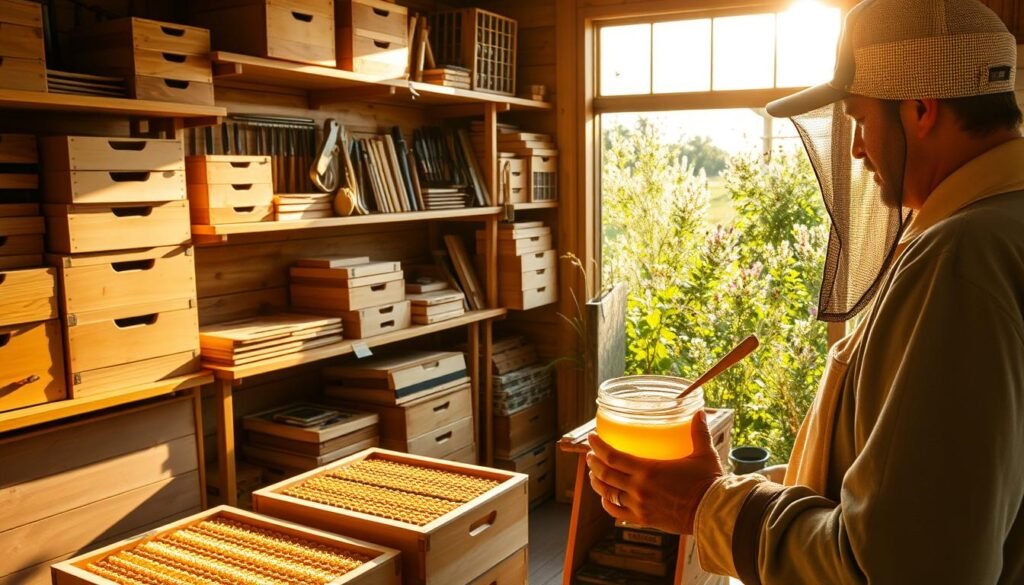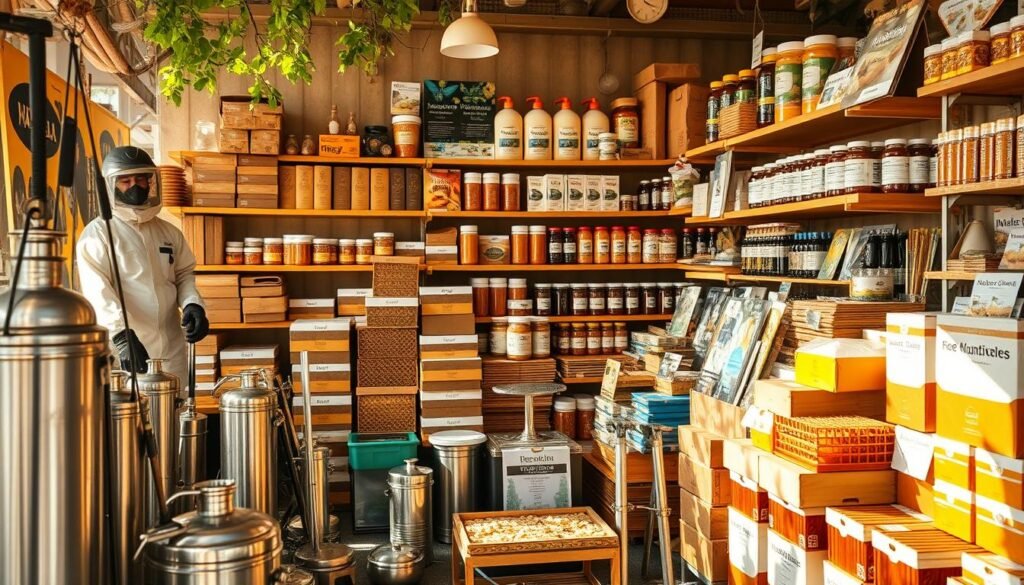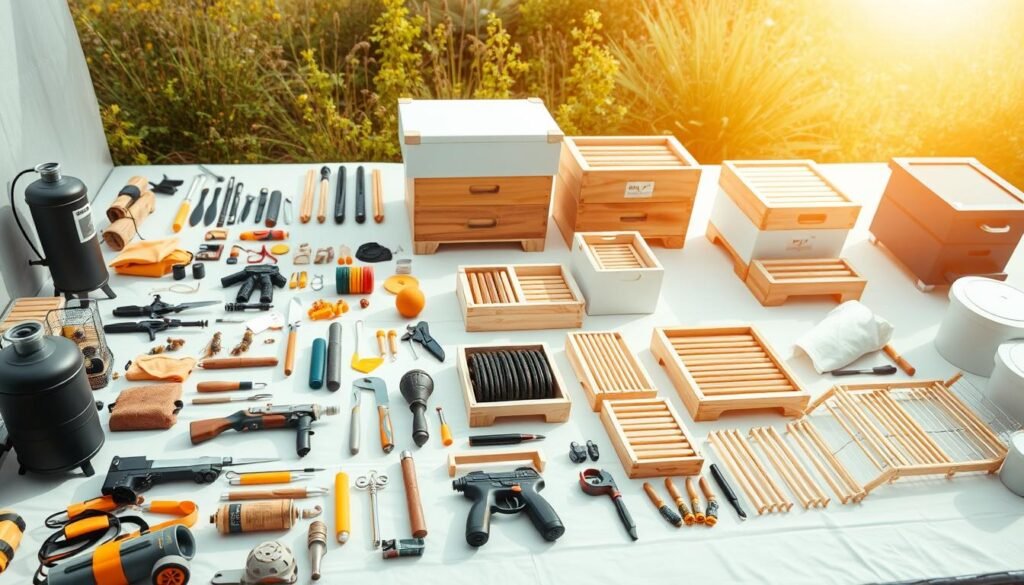Discovering unwelcome buzzing visitors on your property can quickly become a serious concern. These industrious creatures, while vital to our ecosystem, may establish hives in risky locations like wall cavities or roof spaces. Local specialists offer swift, humane solutions to resolve these situations without harming the environment.
With over 15 years’ experience, Perth’s trusted experts handle both residential and commercial cases across the metro area. Their same-day response teams use cutting-edge methods to relocate colonies safely, prioritising property protection and occupant safety. Transparent pricing and eco-friendly practices ensure peace of mind for homeowners and business operators alike.
Qualified technicians follow strict protocols during operations, adhering to Australian wildlife regulations. Services extend from initial inspections to tailored prevention strategies, covering suburbs from Yanchep to Mandurah. This approach minimises structural risks while preserving our native pollinators.
Key Takeaways
- Local specialists provide fast, eco-conscious solutions for properties across metro areas
- Advanced relocation methods protect both structures and insect populations
- Emergency response teams available 24/7 for urgent cases
- Fully licensed operators comply with national wildlife protection laws
- Preventative advice helps avoid repeat occurrences
Introduction to Bee Removal in Perth
Balancing human safety with ecological responsibility remains central to managing pollinators in urban spaces. While these insects contribute significantly to Australia’s food systems, their presence near homes or workplaces demands careful handling.
Why Bee Control Matters in Australia
Stinging incidents cause more hospitalisations than spider or snake encounters nationwide. Over 42,000 Australians require emergency care annually due to allergic reactions. Proper management reduces risks while safeguarding agricultural productivity, as two-thirds of crops depend on pollination.
Guardians of Environmental Health
Native species fertilise both farmlands and wild plants, supporting food security and biodiversity. Experts prioritise relocation strategies that protect colonies, ensuring their continued role in ecosystem stability. Specialised technicians identify species requiring preservation or alternative solutions, maintaining nature’s delicate balance.
Urban infestations often occur in wall cavities or roof spaces, creating urgent safety concerns. Licensed operators use targeted methods to address these challenges, aligning with wildlife protection laws. This approach minimises property damage while supporting environmental conservation efforts across communities.
Understanding Bee Behaviour and Risks
Warmer months bring increased insect activity across Western Australia, particularly from September through April. During this period, flying colonies actively scout for sheltered spaces to establish new nests. Residential eaves, garden sheds, and unused outdoor equipment often become prime targets for these organised groups.

Colony Expansion and Nesting Habits
Swarm behaviour follows seasonal patterns influenced by temperature and food availability. Colonies prioritise secure locations near water sources and flowering plants. Early signs include:
- Consistent buzzing near structural gaps
- Visible wax deposits in roof cavities
- Sudden appearance of multiple insects around specific areas
Balancing Wellbeing With Ecological Needs
Stinging incidents account for 65% of insect-related hospital admissions nationally. While most reactions involve localised swelling, vulnerable individuals face life-threatening risks. Specialists employ protective gear and behavioural knowledge to:
- Prevent aggressive responses during interventions
- Identify species requiring preservation
- Implement relocation strategies supporting local ecosystems
Untrained handling often escalates defensive behaviours, endangering both people and pollinators. Qualified technicians use thermal imaging and non-invasive techniques to resolve infestations while maintaining environmental balance.
Our Comprehensive bee removal perth Services
Managing pollinators in urban environments requires adaptable strategies for different property types. Our specialists deliver tailored approaches for homes and businesses across the metro area, combining precision techniques with ecological awareness.
Tailored Approaches for Homes and Businesses
Property-specific strategies address unique challenges in various environments. Residential cases often involve nests in eaves or garden structures, while commercial sites face larger colonies in complex architectures.
| Residential Solutions | Commercial Solutions |
|---|---|
| Single-family homes | Office complexes |
| Garden sheds & fences | Warehouse facilities |
| Tree branch nests | Retail spaces |
Skilled Technicians and Rapid Response
Our field teams deploy advanced tools like thermal scanners and protective gear during operations. Same-day interventions handle urgent cases where colonies threaten daily activities.
Key service features include:
- Live colony relocation partnerships with local apiarists
- Structural damage prevention during extraction
- 24/7 availability for emergency callouts
Technicians complete most interventions within 4 hours, restoring safety while preserving essential insect populations. Post-service guidance helps property owners maintain pollinator-friendly zones away from high-traffic areas.
Eco-Friendly and Humane Bee Control Methods
Modern pest management now combines property safety with ecological stewardship through innovative techniques. Specialists employ strategies that protect both human spaces and beneficial insect populations, creating balanced solutions for urban environments.

Live Relocation Strategies
Advanced relocation processes focus on preserving entire colonies during interventions. Teams use temperature-controlled containers and specialised vacuums to safely transfer hive residents, ensuring queens and workers remain intact. This method maintains colony cohesion for successful reintegration into new habitats.
| Traditional Approach | Modern Technique |
|---|---|
| Chemical treatments | Non-toxic deterrents |
| Hive destruction | Structural preservation |
| Colony elimination | Apiary partnerships |
Conservation-Focused Practices
Environmental impact guides every decision in contemporary pest management. “We’re not just removing insects – we’re relocating essential pollinators,” notes a local apiarist involved in habitat restoration projects. Key conservation measures include:
- Mapping relocation sites with native flora
- Using biodegradable cleaning agents
- Coordinating with agricultural reserves
These methods reduce stress on transferred colonies while supporting Australia’s food production networks. Regular monitoring ensures relocated groups thrive in their new environments, continuing their crucial pollination work.
Prevention and Maintenance Tips for a Bee-Free Environment
Keeping your living spaces secure requires proactive measures that address both current and potential future issues. Strategic planning reduces the likelihood of unwanted visitors while maintaining outdoor areas as welcoming spaces for people and nature.
Ongoing Home Protection and Sealing Techniques
Entry points around roofs, windows, and pipes often serve as gateways for small intruders. Use silicone-based sealants to close gaps wider than 6mm, paying special attention to eaves and ventilation spaces. For larger cavities left by previous nests, expanding foam blocks residual scents that attract new colonies.
Landscaping choices significantly impact your property’s appeal. Trim flowering shrubs near buildings and fix leaky taps to reduce water sources. Wasp traps placed 10 metres from seating areas help manage secondary attractants without harming beneficial species.
Regular Inspections and Preventative Measures
Quarterly checks of sheds, fences, and roof spaces catch early warning signs. Look for wax residues or increased activity around specific zones. Professionals recommend treating old nest locations every 90 days to disrupt pheromone trails.
Maintain clear records of past activity to predict future hotspots. Combine visual inspections with simple deterrents like cinnamon oil near potential entryways. “Consistency matters more than intensity in long-term prevention,” advises a Perth-based pest controller.
Customised Bee and Wasp Removal Solutions for Perth
Effective management of flying pollinators requires solutions as unique as your property. Local specialists design interventions that address specific challenges while respecting ecological balance and budget considerations.
Personalised Treatment Strategies
Technicians begin with thorough evaluations of colony characteristics and structural risks. Assessments consider three key factors:
- Species identification through visual markers
- Nest accessibility and surrounding infrastructure
- Environmental impact projections
This data informs tailored plans combining immediate action with long-term prevention. Property-specific solutions might involve modified extraction techniques for heritage buildings or non-invasive methods near sensitive ecosystems.
Transparent Pricing and No Hidden Costs
Clients receive detailed quotes outlining service inclusions before work commences. Pricing structures reflect:
- Complexity of access requirements
- Equipment and labour needs
- Post-service monitoring commitments
“We believe honesty builds trust,” states a lead technician. Weekend callouts and emergency situations maintain fixed rates, with price guarantees for pre-approved plans. Free reassessments ensure continued effectiveness of implemented strategies.
Ensuring Safety and Minimising Property Damage
Protecting households while preserving structural integrity forms the foundation of responsible colony management. Our specialists implement strategies that shield occupants and buildings during interventions, addressing both immediate risks and long-term prevention.
Safe Removal Protocols and Family Protection
Secure work zones prevent accidental encounters during operations. Technicians establish 10-metre exclusion areas using visual markers and temporary barriers. This safeguards children, pets, and neighbours from unexpected stinging incidents.
Specialised extraction tools access nests in roofs or walls without damaging surfaces. Heat-sensitive cameras locate hidden colonies, while vacuum systems capture insects with 98% efficiency. Protective suits and smoke deterrents ensure technician safety during delicate procedures.
| DIY Approach | Professional Method |
|---|---|
| Limited visibility of nest locations | Infrared scanning for precise detection |
| Potential structural damage | Non-invasive access techniques |
| Increased stinging risks | Contained removal processes |
Aftercare and Continuous Monitoring
Post-service inspections occur at 48 hours and 2 weeks post-intervention. Technicians check treated areas for residual activity and seal entry points. “Prevention beats cure every time,” notes a senior operator, emphasising regular maintenance.
Monitoring programs include:
- Seasonal property assessments
- Pheromone disruption treatments
- Landscaping adjustments near buildings
These measures reduce re-establishment risks by 82% in controlled studies. Clients receive customised schedules based on local pest patterns and building layouts.
Experience and Expertise of Our Local Bee Control Team
Local expertise forms the backbone of reliable pollinator management solutions. Our specialists combine technical precision with environmental awareness developed through decades of service. This approach addresses immediate safety concerns while supporting broader ecological balance.
15 Years of Industry Experience
Over 5,000 successful interventions across Western Australia have refined our methods. Technicians maintain current certifications in species identification and habitat preservation. Regular training updates ensure compliance with national safety standards and conservation laws.
The team handles intricate cases involving structural complexities or protected colonies. Specialised equipment allows access to hives in roof cavities without damaging property. “Every situation teaches us something new,” remarks a senior operator.
Trusted Client Testimonials and Community Impact
Long-term clients frequently praise our responsiveness and care for local ecosystems. One homeowner noted: “They transformed our backyard nightmare into a safe space within hours.” Partnerships with agricultural groups help relocate colonies to areas needing pollination support.
Community initiatives include:
- Educational workshops on coexisting with native species
- Support for urban greening projects
- Collaborations with wildlife rehabilitation centres
These efforts demonstrate our commitment beyond basic pest management services. The team continues setting industry benchmarks through innovation and ethical practices.
Conclusion
Addressing unwelcome colonies requires expertise and environmental care. Local specialists deliver swift solutions that protect both properties and pollinators, using methods aligned with Australia’s biodiversity goals. Their approach combines technical skill with deep ecological understanding.
Eco-conscious strategies ensure relocated groups continue supporting our food systems and native flora. Advanced swarm removal techniques prevent structural harm while maintaining safety for families and pets. Services across Perth suburbs adapt to each location’s unique needs, from compact houses to sprawling commercial sites.
Regular maintenance plans and 24/7 emergency responses provide lasting peace of mind. Trust qualified teams who prioritise humane practices and transparent communication. For tailored assistance, contact professionals offering sustainable solutions that benefit your space and local ecosystems equally.




